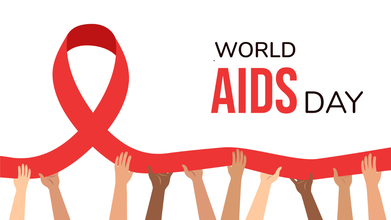- Health Conditions A-Z
- Health & Wellness
- Nutrition
- Fitness
- Health News
- Ayurveda
- Videos
- Medicine A-Z
- Parenting
World Drug Day 2025: Why Is It Important For Us To Observe This Day?

Credits: Canva
World Drug Day is marked on June 26 every year. Also known as the International Day against Drug Abuse and Illicit Trafficking, this day aims to strengthen action and cooperation in achieving a world free of drugs, notes the United Nations.
History of World Drug Day
It was on December 7, 1987, when by the resolution 42/112. the General Assembly decided to observe 26 June as the International Day against Drug Abuse and Illicit Trafficking to achieve a society free of drug abuse.
World Drug Day 2025 Theme
This year's theme is "The Evidence is Clear; Invest in Prevention." This theme highlights the urgent need to invest in preventative measures to address the world's drug problem. It also aims to create a long-lasting resilience against drug abuse.
ALSO READ: RFK Jr. Opens Up About Heroin Addiction and Calls for Focus on Prevention
Importance of World Drug Day
Drug abuse is a global challenge and harms individual silently. It is often the reason why families break and communities weaken. The impact goes beyond addiction, causing a lasting physical, mental, and social damage. Furthermore, ATS, also known as the Amphetamine-Type Stimulants are synthetic drugs that harm the brain, heart, and nervous system.
As per the 2024 report by UN Office on Drugs and Crime (UNODC), number of people who use drugs has risen to 292 million in 2022, a 20% increase over the 10 years. Cannabin remains the most widely used drug worldwide, with an estimate of 228 million users. It is followed by opioids with 60 million users, ATM with 30 million users, cocaine with 23 million users, and ecstasy with 20 million users.
READ: What Are The Most Abused Drugs In The US?
The report notes that nitazenes, which is a group of synthetic opioids which can be even more potent than fentanyl, have recently emerged in several high-income countries, resulting in an increase in overdose deaths.
Though an estimated 64 million people worldwide suffer from drug use disorders, only one in 11 is in treatment. Women receive less access to treatment than men, with only one in 18 women with drug use disorders in treatment versus one in seven men.
These numbers show why is it important to observe World Drug Day, so a society free of drug abuse can be achieved.
Drug Impact On Health
As per the notification released by Government of India on the International Day Against Drug Abuse and Illicit Trafficking 2025, here are the health issues that are caused by various drugs:
- Methamphetamine (Meth): A crystal-like drug that severely damages the brain and heart.
- Cocaine: A white powder that can cause heart attacks and strong addiction.
- Mephedrone: A party drug that leads to anxiety, confusion and heart issues.
- Hashish: Made from cannabis, it affects memory and mental health.
As per the National Institute on Drug Abuse's publication titled, Drugs, Brains, and Behavior: The Science of Addiction, people with addiction often have one or more associated health issues, which could include lung or heart disease, stroke, cancer, or mental health conditions.
Furthermore, use of methamphetamine can cause severe dental problems, which is also known as meth mouth. The study notes, "in addition, some drugs, such as inhalants, may damage or destroy nerve cells, either in the brain or the peripheral nervous system (the nervous system outside the brain and spinal cord)."
Use of drugs can also increase the risk of contracting infections. The study notes: "HIV and hepatitis C (a serious liver disease) can occur from sharing injection equipment or from unsafe practices such as condom-less sex.40,41 Infection of the heart and its valves (endocarditis) and skin infection (cellulitis) can occur after exposure to bacteria by injection drug use."
READ: Liam Payne Investigation: How Pink Cocaine Affects You?
Drugs can also cause mental illness and increase the symptoms of anxiety, depression, or even schizophrenia,, as it can trigger specific vulnerabilities. It can also impact pregnant or breastfeeding mother and her baby could go into withdrawal after it's born. This is called neonatal abstinence syndrome (NAS).
This year, not just with the theme, but with the campaign, "Break the cycle. #StopOrganizedCrime", the aim is to highlight the long-term action to break the cycle of drug abuse and its illicit trafficking by addressing root causes, investing in prevention, and building stronger health, education, and social systems.
READ MORE: National Anti-Drug Addiction Day 2024: Reintegrating In Society After Rehab
Delhi Again Wakes Up To Toxic Air After A Brief Respite, Children Are The Worst Hit

Credits: iStock
Delhi pollution continues to worse, while yesterday their was a brief respite when the air quality index (AQI) levels were reported under the 'poor' category, and the AQI dropped to 269 at 7am on November 30. However, today, on December 1, the AQI at several stations crossed 300.
As per the Central Pollution Control Board (CPCB), Anand Vihar recorded an AQI of 325, ITO at 325, Rohini at 341, Bawana at 339, RK Puram at 336, Vivek Vihar at 321, Shadipur at 324, and Pusa at 322.
Children Are The Worst Victims Of Delhi Pollution
The toxic air in Delhi has spared no one, but the worst affected are children. On a recent weekday morning in Noida, a suburb near Delhi, BBC reported that at a crowded children’s clinic parents waited anxiously with little ones who were coughing, wheezing or struggling to breathe.
Most families said their children started falling sick in October, right when the capital’s air quality slipped into the hazardous range. This is a yearly pattern across northern India. A mix of slow winds, industrial fumes, vehicle emissions, dropping temperatures and the burning of crop residue creates a thick layer of pollution that settles over the region.
Since last month, Delhi’s Air Quality Index has mostly stayed between 300 and 400. These levels are over 20 times higher than what the World Health Organization (WHO) considers safe. Readings this high affect everyone, but young children and older adults are the most vulnerable.
Hospitals across the city have been overwhelmed with children suffering from pollution-related illnesses. Dr Shishir Bhatnagar, who heads the clinic in Noida, told BBC the number of cases has jumped sharply. He explained that young children are especially at risk because their immunity is still developing. He usually sees about 20 to 30 percent of cases linked to pollution, but that number doubles during the winter smog.
Although authorities often introduce emergency measures like halting construction or restricting vehicles, the situation has barely improved. Even an attempt at cloud seeding this year failed to bring relief, leaving millions worried about their families’ health.
For some parents, the fear is constant. BBC reports that Khushboo Bharti remembers rushing her one-year-old daughter to the hospital after a severe coughing fit left the baby vomiting and struggling to stay alert. The toddler later needed oxygen and was diagnosed with pneumonia. Other parents share similar worries, wondering whether the polluted air might cause lasting harm.
Research has repeatedly shown that prolonged exposure to polluted air can impair lung development, weaken immunity and even affect brain health. A recent study from the University of Cambridge linked certain pollutants to higher risks of dementia later in life.
While schools have postponed outdoor activities and moved younger classes online, these precautions mainly help families who have access to resources. For children living in crowded homes or near busy roads, the daily exposure is far worse. Doctors urge parents to keep children indoors when possible and use N95 masks, but many families find this unsustainable.
Parents say they feel helpless. They know children need space to play and fresh air to grow, yet every winter forces them to choose safety over normal childhood experiences.
How To Read AQI?
As per CPCB standards, here's how you can read AQI:
- 0 to 50 Good
- 51 to 100 Satisfactory
- 101 to 200 Moderate
- 201 to 300 Poor
- 301 to 400 Very Poor
- 401 to 500 Severe
World Aids Day 2025: Theme, Origin And Significance

Credits: iStock
Aids Day, a day that focuses on raising awareness on a disease that effects 40.8 million lives. In 2024 alone, 630,000 people died from AIDS-related deaths. What really is AIDS? It stands for acquired immunodeficiency syndrome, which is an advanced stage of HIV, caused by the human immunodeficiency virus. It damages the immune system so that the body is less able to fight infections and diseases.
Thus, every year, on December 1, World AIDS Day is observed to increase awareness on the same, provide support to people living with it and remember those who have lost their lives to the illness.
World Aids Day 2025: Theme
This year, the theme for Aids Day is "Rethink, Rebuild, and Rise".
The International AIDS Society (IAS) wants to create a simple message through the theme that it is important for everyone to connect and work against HIV. This is an urge to everyone from local activists to scientists, to governments, and to the global organization.
The world’s fight against HIV is entering a critical phase. Hard-won progress is under threat as political tensions grow and funding becomes uncertain. This year’s theme, “Rethink. Rebuild. Rise.” is a powerful reminder that the global community must stay united, resilient and forward-thinking to meet the challenges ahead.
Rethink calls for stronger, long-term financial planning. It urges countries to invest more of their own resources instead of relying mainly on international support.
Rebuild highlights the need to strengthen health systems, protect scientific research and support civil society groups. It also emphasizes grounding every decision in solid evidence and pushing back against misinformation.
Rise encourages the world to move ahead with a fully funded, people-centered strategy that safeguards past achievements and brings us closer to ending AIDS as a public health threat by 2030.
Importance Of World Aids Day 2025
The United Nations notes that in 2025, funding crisis is threatening the progress made in the prevention of the illness. This is why this day is a reminder for more people to connect, initiate community services that are vital for the marginalized population who are often deprioritized while the rise in punitive law criminalizes same sex relationships, gender identity, and drug use that amplifies the crisis, and makes HIV-AIDS services inaccessible.
The global response to AIDS has been shaken in recent months, and much more work is needed to meet the Sustainable Development Goal of ending AIDS by 2030. The crisis is far from over, and in today’s challenging environment, a fresh, transformative strategy is essential to reduce risks and stay on track.
World Aids Day: Origin
The day was first observed in 1988 when the World Health Organization (WHO) and the United Nations first launched it to spread awareness about HIV/AIDS, erase misconception, and build empathy for people living with AIDS. This day reminds people around the world that AIDS is not only a health problem but also a social and humanitarian issue for which everyone should work together.
Can You Prevent AIDS?
The prevention of AIDS starts from the restriction and complete stoppage of HIV. While there is no vaccine or permanent cure yet, there are ways to prevent AIDS:
- Practice Safe Sex
- Don't Share Needles
- Prevent Mother-to-child Transmission
- Ensure Safe Blood Transfusions
Did the Covid Vaccine Kill 10 Children? An FDA Memo Raises Troubling Questions; Here's What We Know So Far

Credits: iStock
Vaccine safety, a debate the Trump administration just cannot let go. Once again, the same debate is stirring up, and this time an internal Food and Drug Administration memo that The New York Times obtained has linked death of at least 10 children to the COVID vaccine. While the document has not been released publicly, it has already caused controversy and prompted talk of tighter regulations.
The New York Times however reports that the memo did not include essential such as the ages of the affected children, any underlying health conditions, or how the agency reached its conclusions. It also did not identify which manufacturers’ vaccines were involved. Since the findings have not been published in a peer-reviewed journal, many critics of Health Secretary Robert F. Kennedy Jr. have raised concerns about the accuracy and timing of the claims. Kennedy has long questioned the safety of Covid shots, even as scientific consensus maintains that vaccines are safe and have saved countless lives.
So, What Does The Memo Say About Vaccination And Death Of Children?
Dr Vinay Prasad, who is the head of FDA's vaccine division wrote the memo based on the findings of a review of reports that suggested that the deaths were linked to myocarditis, which is a rare inflammation of the heart muscle.
But, what does the science say? Scientists have studied the connection between Covid vaccines and myocarditis for years, especially among teenage boys and young men. Most studies have shown that the condition is rare and usually resolves quickly.
Even so, Dr Prasad wrote to staff that the memo marked the first time the FDA would acknowledge that Covid vaccines may have played a role in the deaths of American children. He indicated that he would propose several new oversight measures. It is unclear whether the White House had been briefed on these plans or how closely officials would follow them. When The New York Times reached out to Department of Health and Human Services for a comment, the request was declined.
A Shift In Vaccine Policy
This memo comes at the time when the administration has already taken a more cautious stance on vaccines. Kennedy's team has already introduced new limits on who can or cannot receive COVID shots. The shot has now been restricted to people over 65 and younger individuals with medical vulnerabilities. Officials have also called for renewed studies on long-established vaccines that have been considered safe for decades.
Public health experts from previous administrations have warned that casting doubt on vaccines could have serious consequences. Covid has killed more than a million Americans, including about 2,100 children. Experts note that many more lives were saved because vaccines became widely available.
What Are The Experts Saying?
The memo appeared just before a significant upcoming meeting of the CDC’s vaccine committee, which now includes members known for supporting the medical freedom movement. Michael Osterholm, an infectious disease specialist, said the timing did not seem accidental and called the release “irresponsible.”
Other experts expressed concern that the memo lacked important context. Dr. Paul Offit of the Children’s Hospital of Philadelphia pointed out that myocarditis from Covid infection itself has been far more severe than the rare cases linked to vaccines.
Dr. Prasad also criticized previous mandates for school and workplace vaccination, claiming they pressured people into receiving shots that might pose risks. His memo ended by addressing internal disagreements within the agency and outlining how staff should resign if they oppose the new direction.
© 2024 Bennett, Coleman & Company Limited

